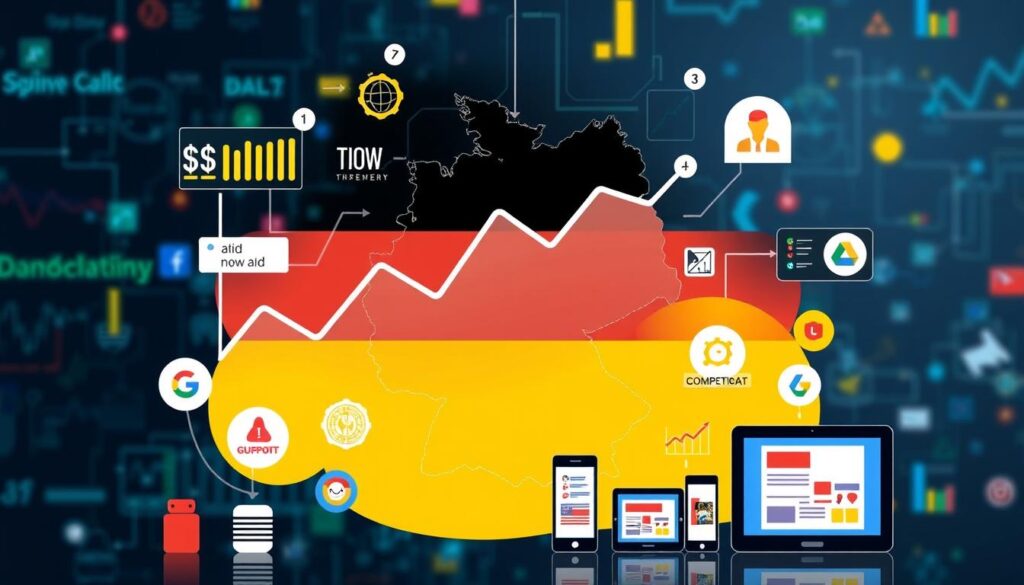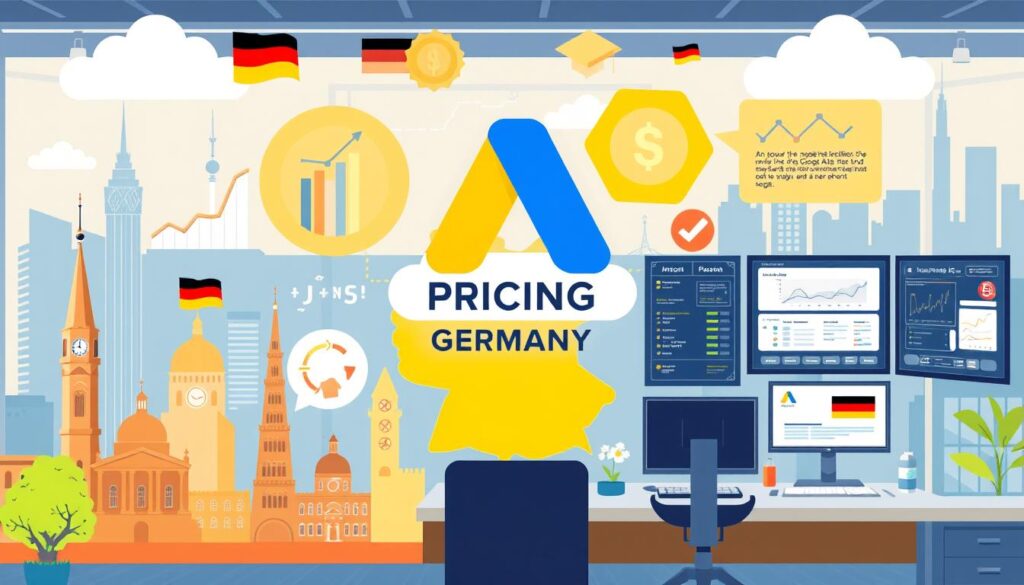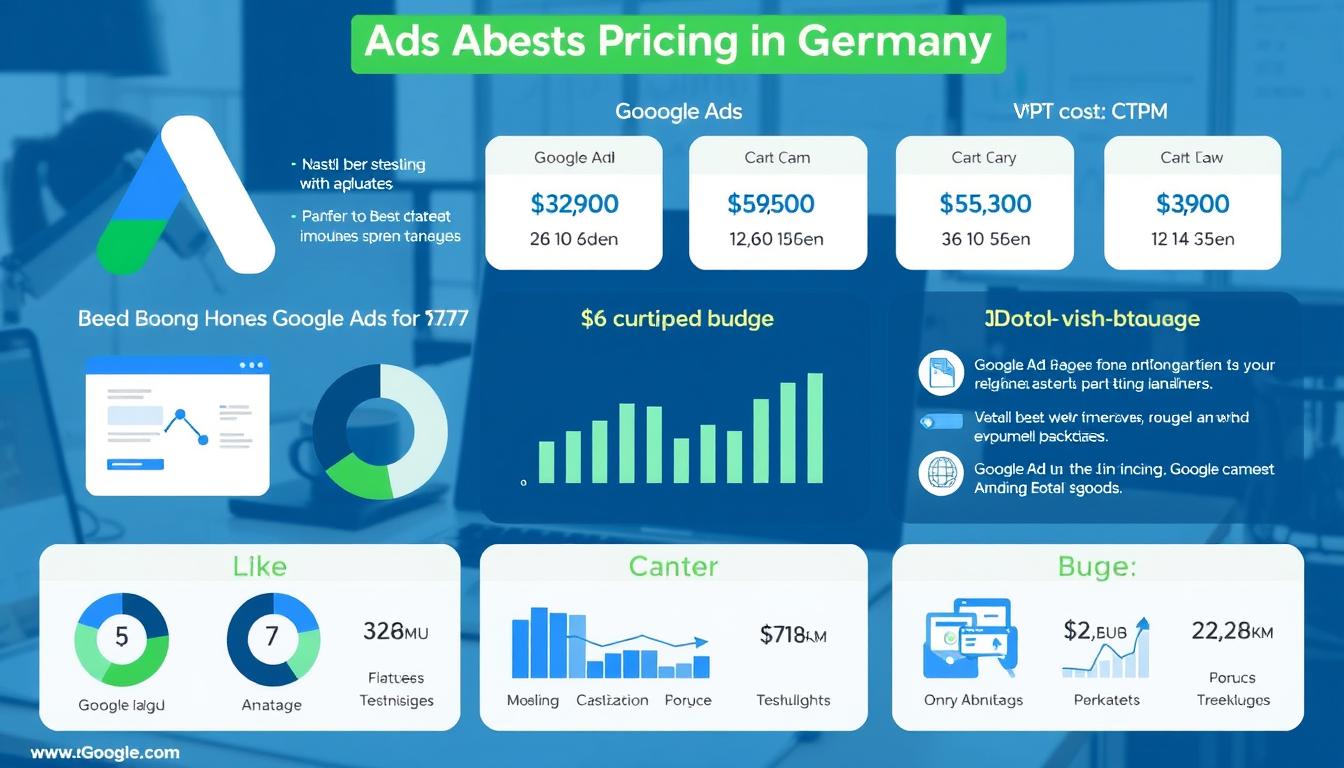For businesses in Germany, knowing the cost of using Google Ads is key. Many things affect Google Ads pricing, which changes how much you’ll spend. In Germany, the price of Google Ads can change a lot. It depends on your industry, how competitive it is, and the ad types you use.
For instance, Display Network ads with a CPM bidding model can cost between €0.48 and €1,100 per 1,000 impressions1. Also, 37% of businesses on the Google Search Network pay between €0.11 and €0.50 per click1. This shows how different the costs can be. It’s important to understand these costs to plan your budget well.
This information will help you understand Google AdWords pricing better. It will help you make the most of your ad spend in your marketing campaigns.
Key Takeaways
- The cost of using Google Ads in Germany varies based on competition and industry.
- Businesses can expect to spend between €0.11 to €1.00 per click on average.
- Ad costs can range from €0.48 to €1,100 per 1,000 impressions, depending on the ad format.
- Tracking and understanding pricing structures are vital for optimizing marketing budgets.
- Many companies in Germany spend between €100 to €10,000 on Google Ads monthly.
- Effective budget planning requires knowledge of average CPC rates and industry standards.
Understanding Google Ads Pricing
Businesses looking to invest in Google Ads need to know the different payment models. It’s key to understand google ads pricing to get the most out of your investment. The most common model is cost-per-click (CPC), where you pay for each ad click. This model focuses on bringing traffic to your site and costs vary based on keyword competition and bidding.
There’s also the cost-per-thousand impressions (CPM) model. This charges for every 1,000 ad displays, no matter if anyone clicks on them. This flexibility lets advertisers match their strategy to their marketing goals.
Overview of Google Ads Payment Models
When planning your google ads budget, it’s important to know how different ad formats affect pricing. You can set daily or campaign budgets to manage your CPC spending. Google’s digital ad revenue is huge, nearing $240 billion, with over 80% of companies using it for their ads2.
CPC costs can range from $2.50 to $45, depending on keywords, ad quality, and bidding2. The Quality Score, which affects CPC, is crucial. Different industries have different pricing, with finance and healthcare often being more expensive, requiring bigger budgets3.
Difference Between CPC and CPM
The choice between CPC and CPM depends on your campaign goals. CPC is best for driving traffic and getting specific actions, while CPM is for brand awareness. Understanding these models helps manage costs and achieve goals.
In competitive sectors like finance and insurance, CPC rates can be high. Popular keywords can cost between $5 and $60 per click2. This makes it crucial to plan your budget well to keep costs in check3. Knowing the difference between these models is essential for optimizing ad spend and getting the best return on investment.
How Much Does It Cost to Use Google Ads?
For advertisers in Germany, knowing the cost of Google Ads is key. The monthly spend can range from €100 to €30,000, depending on the business size and goals. Small-to-medium businesses usually spend between $1,000 and $10,000 a month, showing their marketing goals4.
Monthly Spending Ranges in Germany
When setting Google Ads budgets, it’s important to think about the competitive market and industry specifics. Industries like legal services and healthcare face higher CPCs due to intense competition. Businesses can find a wide range of spending options, fitting different marketing plans and goals4.
Average Cost Per Click (CPC) Breakdown
The average Cost Per Click (CPC) for Google Ads is about $2.69. But, industries like legal services can see costs up to $8.94 per click. Home Improvement and Dentists have CPCs around $6.96 and $6.82, respectively5.
On the other hand, Arts & Entertainment and Travel have much lower CPCs, averaging $1.72 and $1.925. This shows how crucial it is to do a detailed google ads cost analysis to spend wisely.
| Industry | Average CPC |
|---|---|
| Attorneys & Legal Services | $8.94 |
| Home & Home Improvement | $6.96 |
| Dentists & Dental Services | $6.82 |
| Arts & Entertainment | $1.72 |
| Travel | $1.92 |
| Real Estate | $2.10 |
These figures show a big difference in Google Ads costs across various sectors. This encourages advertisers to choose their options carefully5.
Factors Affecting Google Ads Pricing
It’s important to know what affects Google Ads pricing to get the most from your budget. Key factors include industry competition, keyword choice, and Quality Score. Each plays a big role in the google ads cost per click.
Industry Competition and Its Impact on Costs
Industry competition can really change google ads pricing. For example, fields like law and insurance often see high CPC rates. Lawyers might pay up to $12 per click in good campaigns6.
Insurance and finance are among the priciest, with costs over $507. This high competition can make monthly ad spending vary a lot. About 44% of marketers spend between $100 and $10,000 on Google Ads7.
Keyword Selection and Relevance
Picking the right keywords is key to keeping costs down. The relevance of your keywords affects how Google rates your ads. This, in turn, impacts their cost and placement8.
Using long-tail keywords can help lower CPC by targeting less competitive areas. Seasonal changes and market trends also play a part, changing keyword competitiveness and google ads cost per click a lot6.
Quality Score and Its Role in Pricing
Quality Score is how Google judges your ads, keywords, and landing pages. A better Quality Score means lower CPC and better ad placement. This leads to better campaign performance.
With 80% of businesses worldwide using Google Ads, managing Quality Score is crucial for cost efficiency and ROI8. Boosting Quality Score can save a lot of money. It’s vital to create relevant content and optimize ads for this.

Google Ads Budget Planning
Planning your Google Ads budget is key to great ad performance and getting the most value. You should set both a monthly and daily budget based on your goals and expected results. To find your daily budget, just divide your monthly budget by 30.4 days9.
While there’s no minimum spend, it’s wise to start with at least $5-10 a day. This is because the competition is fierce10.
Setting a Monthly and Daily Budget
When setting your monthly budget, think about your industry, average cost per click (CPC), and how important each campaign is. For example, aiming for a $50,000 ROI each month means setting a daily budget of about $6,25010.
Google Ads costs vary by industry. New advertisers should research CPC trends in their field. This is because these trends greatly affect your overall cost9.
Adjusting Budget Based on Campaign Performance
Keeping a close eye on your campaigns and making adjustments is crucial for keeping costs down. Google can spend up to 100% more than your daily budget during active campaigns9.
If you find strategies that work, you can increase your budget to grow successful campaigns. It’s also important to understand Quality Score, which ranges from 1-10. This score affects where your ads are placed and how much they cost9.
Staying focused on buying intent keywords can lead to better CPC management and ad performance.
Google Ads Cost Per Click
Knowing the cost per click on Google Ads is key for advertisers wanting to get the most from their money. The price per click changes a lot between different industries. This shows how competitive each field is and what kind of products or services are being promoted.
Typical CPC Ranges by Industry
In Germany, the average cost per click varies a lot across different sectors. For example, finance, insurance, and gambling ads can cost over $50 to $100. This is because their content is very sensitive11. On the other hand, health and fitness ads average around $4.71 per click12.
Less competitive areas might have lower CPCs, helping marketers stretch their ad budgets. Also, seasonal trends affect CPC, with retail and travel seeing big spikes during major shopping times11.
How Keyword Competition Influences CPC
Keyword competition is a big factor in Google Adwords pricing. Advertisers in very competitive fields need to spend more to get clicks. But, those targeting specific, less competitive keywords might get better deals. Using smart keyword strategies can lead to big savings, up to 50% off CPCs, thanks to higher quality scores11.
Google AdWords Pricing Overview
For businesses, understanding Google AdWords pricing is key to managing their online ad budgets. Google Ads costs can vary a lot compared to other platforms. For instance, Google Ads uses a pay-per-click model, where the bid sets how much an advertiser pays for a click13. Legal and finance industries often see higher costs, sometimes up to €20 per click14.
Comparing AdWords Costs to Other Platforms
Google AdWords pricing stands out when compared to other platforms. Social media ads might be cheaper but lack Google Ads’ precision. Google ensures businesses can track their ad spending easily. Small businesses might spend €1,000 to €10,000 a month, while big companies could spend millions14.
Understanding Cost Per Acquisition (CPA)
Cost Per Acquisition (CPA) is key to measuring a Google Ads campaign’s success. Keeping CPA low is essential for good returns on investment. In Germany, a CPA might be around €40, but costs can change based on competition and strategy13.

Google Ads Campaign Cost Estimator
Figuring out the cost of a Google Ads campaign means looking at different metrics. You also need to use tools for google ads budget planning. These tools give a detailed look at what you might spend and what you might get back.
Using Tools to Estimate Campaign Budget
The Google Ads cost estimator is a great tool for advertisers. It helps understand how well a campaign works by looking at things like budget, cost per click (CPC), and expected conversions15. It calculates the total cost of a campaign using important metrics like cost per acquisition (CPA). It also lets you compare your costs to what others in the industry are paying15.
By trying out different budget scenarios, you can guess what future costs might be. This helps you plan your spending better to get a higher return on investment15.
Planning for Variable Costs
It’s important to think about things that can change, like the seasons and market trends, when planning your budget. A good way to estimate costs is to use a formula like this: (Total Ad Spend / Number of Clicks) x Click-Through Rate x Conversion Rate x 36516. This helps make a solid financial plan16.
Remember, improving your keywords and making your landing pages better can also affect your costs16.
Breakdown of Google Ads Cost Calculation
For businesses, understanding Google Ads costs is key to using their budget wisely. Google Ads uses an auction system, where many factors affect ad prices across different fields. These factors not only decide where ads appear but also how much they cost.
Understanding the Ad Auction Process
The ad auction in Google Ads looks at the bid, ad quality, and how well it matches what users want. Businesses need to bid smartly to get their ads seen without overspending. Industries like law, accounting, and real estate often face tough competition, making their ad costs higher.
In 2023, mobile devices made up 53.66% of all website visits. This shows how important it is for businesses to think about mobile strategies.
Factors Included in Cost Calculation
Many things affect the cost of a Google Ads campaign. These include the bidding strategy, who the ads are for, and where they are shown. For example, ads for local areas can cost a lot less than those for the whole country.
Industries like insurance and finance often have high CPCs because of the cost of converting customers. These costs can range from $30 to $200. Businesses might see their Google Ads costs change from month to month because of things like sales and seasonal changes.
Analyzing Google Ads Campaign Cost
Understanding Google Ads costs is key for businesses to improve their ads. A detailed google ads cost analysis helps measure ROI, which is crucial for making smart choices. In Germany, businesses usually spend $9,000 to $10,000 a month on Google Ads. Small businesses start with as little as $1,50017.
To better plan google ads budget, finding ways to spend less while getting more is essential.
Measuring ROI for Campaigns
Measuring ROI means looking at how much money is made versus how much is spent on ads. Google Ads campaigns can bring in an average ROI of 200%17. Businesses must tweak their plans based on how well they do to stay profitable.
Knowing CPC rates by industry, like $1.16 in ecommerce and $6.75 in legal, helps fine-tune ads18.
Identifying Cost-Effective Strategies
Using targeted ads makes spending more effective, as reaching the right people costs more due to competition. Making ad copy better and using analytics tools can boost campaign success while keeping costs down. Market trends and seasonal changes can also impact costs, so adjusting bids is often needed to stay competitive17.
Estimating the Return on Investment (ROI)
Understanding the return on investment (ROI) in Google Ads is key for advertisers. Knowing the cost of Google Ads helps businesses check their campaign’s performance. By tracking conversions, advertisers see how well their strategies work.
Importance of Tracking Conversions
Tracking conversions is vital for accurate ROI assessment. Google says the average ROI is 100%, meaning advertisers get $2 for every $1 spent19. But, different industries have different ROI goals. For example, e-commerce aims for ROIs over 300%19. Knowing these numbers helps in planning Google Ads budgets and setting realistic goals.
Balancing Cost and Effectiveness
It’s important to balance ad costs with revenue to see if you’re making money. Good ROI comes from smart ad spending. For example, if a campaign costs $510 and makes $1200, it’s a win20.
To boost ROI, focus on keyword optimization, better ad quality, and constant monitoring19. Success in Google Ads means balancing spending and making money, all while watching industry standards21.
Why Google Ads Can Be Worth the Investment
Google Ads is a smart choice for small and medium-sized businesses. It works on a pay-per-click (PPC) model. This means you only pay when someone clicks on your ad22. It’s a cost-effective way to advertise, especially since the top three ads get over 40% of clicks23.
Long-term Benefits for Small and Medium Businesses
Google Ads offers more than just a good start. It can bring in $2 for every $1 spent, giving a 200% return on investment23. This is great for businesses looking to grow while keeping their marketing costs low. Plus, PPC ads can lead to 50% more sales than organic methods23.
Ad costs can vary based on the industry. Finance and insurance tend to be more expensive due to high competition23. But Google Ads lets you reach a huge audience. With billions of searches every day, you can target your ads to specific groups22.
Google also offers detailed analytics tools. These help businesses track how well their ads are doing in real-time. This way, you can always make your ads better and keep up with market changes22.
Flexibility of Google Ads Spending
Google Ads offers a flexible way to spend money for businesses of all sizes. This flexibility is key for managing budgets well as companies grow and change.
Scaling Budgets Based on Business Growth
Google Ads lets you adjust budgets as your business grows. Small businesses might spend $1,500 to $8,000 a month. Mid-size companies usually spend $7,000 to $30,000 monthly24.
Larger companies can spend even more, from $50,000 to $250,000+24. This way, businesses can change their spending based on how well their ads are doing and their growth.
Effective Cost Management Techniques
To keep costs down, businesses can use several methods. Using shared budgets makes it easier to manage many campaigns at once, especially for big accounts25. Automated rules can also adjust budgets automatically based on certain conditions, making ads more flexible25.
With daily ad budgets from $10 to $500, companies can control their spending better. They can also make sure their ads match what their audience likes24.
Conclusion
Knowing how much Google Ads costs is key for businesses in Germany. This article has covered many important points about Google Ads pricing. These include how competition, choosing keywords, and ad quality affect costs.
The cost per click (CPC) can vary a lot. It can be as low as $0.63 for display network ads or up to $50 in competitive fields like legal services2627.
Having a good budget for Google Ads can help a lot. Many small businesses spend between $9,000 to $10,000 each month on ads26. Using smart cost management can also help businesses spend wisely and get better results from their ads.
Google Ads is very flexible and powerful. It lets businesses adjust budgets and bids based on real-time data. This makes it a great tool for getting more conversions.
In short, understanding Google Ads well can bring big benefits. By keeping an eye on how ads perform and making changes as needed, businesses can handle Google Ads pricing well. This helps them reach their marketing goals more effectively.
